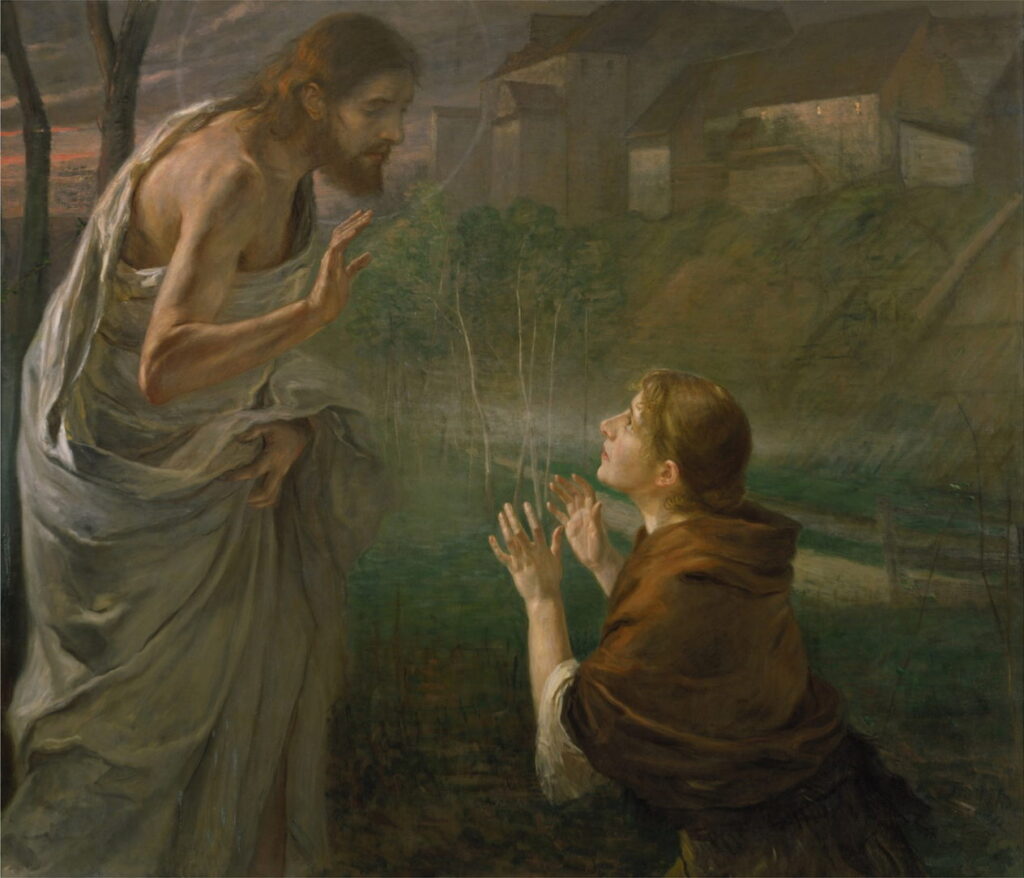Easter Paintings: 3 The Resurrection

This third and final article devoted to paintings of Easter covers the events after the entombment, from Christ’s body in the sepulchre and the harrowing of Hell, to the Resurrection. Although less frequently painted than the Crucifixion, the Resurrection is the whole purpose of Easter.
William Blake (1757–1827), The Angels hovering over the body of Christ in the Sepulchre; Christ in the sepulchre, guarded by angels (c 1805), watercolour, pen and ink on paper, x x y cm, Victoria and Albert Museum (Given by the heirs of Esmond Morse), London. Image courtesy of and © Victoria and Albert Museum, London.
William Blake’s The Angels hovering over the body of Christ in the Sepulchre; Christ in the sepulchre, guarded by angels from about 1805 elaborates the gospel accounts of Christ’s body in the sepulchre with reference to the description of the tabernacle in Exodus, chapter 25 verse 20:
And the cherubims shall stretch forth their wings on high, covering the mercy seat with their wings, and their faces shall look one to another; toward the mercy seat shall the faces of the cherubims be.
This may have been in the light of Hebrews, chapter 9 verse 5:
And over it the cherubims of glory shadowing the mercyseat; of which we cannot now speak particularly.
Jan Brueghel the Elder (1568–1625) and Hans Rottenhammer (1564–1625), Christ’s Descent into Limbo (1597), oil on copper, 26.5 x 35.5 cm, Koninklijk Kabinet van Schilderijen Mauritshuis, The Hague, The Netherlands. Wikimedia Commons.
Just before the end of the sixteenth century, Jan Brueghel the Elder collaborated with Hans Rottenhammer in Christ’s Descent into Limbo (1597). This is set in a grand vision of a dungeon at the edge of a fiery underworld that could have been painted by Hieronymus Bosch.
William Blake (1757–1827), Christ Appearing to His Disciples After the Resurrection (c 1795), color print (monotype), hand-colored with watercolor and tempera, 43.2 x 57.5 cm, The National Gallery of Art (Rosenwald Collection), Washington, DC. Courtesy of The National Gallery of Art.
William Blake’s Christ Appearing to His Disciples/Apostles After the Resurrection is one of his large colour print series from 1795, referring to the gospel of Luke, chapter 24 verses 36-40:
And as they thus spake, Jesus himself stood in the midst of them, and saith unto them, “Peace be unto you.” But they were terrified and affrighted, and supposed that they had seen a spirit. And he said unto them, “Why are ye troubled? and why do thoughts arise in your hearts? Behold my hands and my feet, that it is I myself: handle me, and see; for a spirit hath not flesh and bones, as ye see me have.” And when he had thus spoken, he shewed them his hands and his feet.
William Holman Hunt (1827–1910), Christ and the Two Marys (1847), oil on canvas, 117.5 x 94 cm, Art Gallery of South Australia, Adelaide, Australia. Wikimedia Commons.
William Holman Hunt’s Christ and the Two Marys is an early Pre-Raphaelite painting from 1847, the year before the formation of the Brethren, and a time when religious themes were popular among them. The two Marys are Mary Magdalene and “the other” Mary, while Christ, his stigmata plainly visible, has cast off the bandages his body was wrapped in for burial.
Nikolai Ge (1831–1894), Heralds of the Resurrection (1867), media and dimensions not known, Tretyakov Gallery, Moscow, Russia. Wikimedia Commons.
Nikolai Ge’s Heralds of the Resurrection, from 1867, probably shows Mary Magdalene rushing to tell the disciples of the news that Christ’s body was missing, and that he was resurrected. At the right are the guards who were placed at the tomb, perhaps.
Albert Edelfelt (1854–1905), Christ and Mary Magdalene, a Finnish Legend (1890), oil on canvas, 216 x 152 cm, Ateneumin taidemuseo, Finnish National Gallery, Helsinki, Finland. Wikimedia Commons.
Several impossible legends grew about Mary Magdalene; here Albert Edelfelt’s Christ and Mary Magdalene, a Finnish Legend (1890) dresses her in contemporary clothing, and transports the two to the lakes and forests of Finland, where the first pale leaves of Spring are on the trees.
Fritz von Uhde (1848–1911), Touch me not. John 20:17 (1894), oil on canvas, 144.7 x 168.3 cm, Neue Pinakothek, Munich, Germany. Wikimedia Commons.
Fritz von Uhde has a similarly modern approach in Touch me not. John 20:17 from 1894, this time outside a small town in Germany.
John Roddam Spencer Stanhope (1829–1908), Why seek ye the living among the dead? (St Luke, Chapter XIV, verse 5) (1896), oil on paper, 15.3 × 22.8 cm, location not known. Wikimedia Commons.
John Roddam Spencer Stanhope’s Why seek ye the living among the dead? (St Luke, Chapter 14, verse 5) (1896) refers to the version in which Mary Magdalene and companion(s) return to Christ’s tomb, only to find its door open and the tomb empty. They are then greeted by two men who inform them that Christ has risen from the dead. Stanhope depicts this in the style of a frieze, the four figures arranged across the painting in a single parallel plane. Although part of a complex narrative, he depicts only a limited window from the story, and in doing so makes his painting simpler and more direct.
Eugène Burnand (1850–1921), The Disciples Peter and John Running to the Tomb on the Morning of the Resurrection (1898), oil, dimensions and location not known. Wikimedia Commons.
Late in the nineteenth century, Eugène Burnand’s most successful painting was The Disciples Peter and John Running to the Tomb on the Morning of the Resurrection from 1898, now in the Musée d’Orsay in Paris. Their faces and hands tell so much, surprisingly for an artist who had concentrated for his whole career on landscapes.
Albin Egger-Lienz (1868–1926), Resurrection (1923), oil on cardboard, 71.5 x 101 cm, location not known. Wikimedia Commons.
Albin Egger-Lienz painted a thoroughly modern account in 1923-24. He developed the study above, known simply as Resurrection, into the finished painting of Resurrection of Christ below.
Albin Egger-Lienz (1868–1926), Resurrection of Christ (1923-24), oil on canvas, 197 x 247 cm, Tirol Art Museum, Austria. Wikimedia Commons.
I close with a wonderful painting of a more recent Easter Sunday, by the Ukrainian artist Mykola Pymonenko.
Mykola Pymonenko (1862–1912), Waiting for the Blessing (1891), oil on canvas, 133 x 193 cm, Rybinsk Museum-Preserve Рыбинский историко-архитектурный и художественный музей-заповедник, Rybinsk, Russia. Wikimedia Commons.
Waiting for the Blessing (1891) shows the scene at a country church at dawn on Easter Sunday. The local population is crowding inside, while the women gather with their Paska, traditional ornamental bread that must be blessed before it can be eaten as a brunch. Note how defocussed the crowd in the background appears relative to the women and children in the foreground.
May all our Easters be peaceful, wherever we are!



